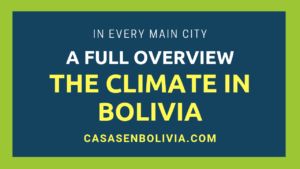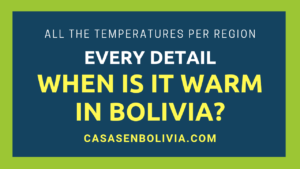Last Updated on February 15, 2025
Contrary to what many foreigners believe, Bolivia is not solely a country of high-altitude Andean landscapes. In reality, Bolivia is predominantly a tropical country, with a portion of its territory even encompassing part of the Amazon rainforest. This results in a nation with diverse climates and regions. Some areas are very cold, others are very hot, and some offer a mild and pleasant climate for living.
Bolivia is simultaneously a cold, hot, and temperate country. It has three main climate zones, each with a distinct average temperature: The Altiplanic West, with an average of 50°F; the tropical East, with an average of 80°F; and the temperate Center, with an average of 70°F.
In this article, we’ll discuss whether Bolivia is a hot or cold country and explore the spectrum of climates and temperatures that Bolivians typically experience. We’ll present all the details about each region and its temperature levels, the coldest and hottest cities, and more. We are Bolivian real estate experts (see our Bolivian website).
Yes, Bolivia is Both Cold and Hot
Bolivia has very distinct regions. One is very cold, while another is quite hot. Additionally, in the center of the country, there’s a mountainous corridor with a temperate climate. In Bolivia, you’ll find three major regions, each with its own climate and temperatures:
- The Altiplanic West (with an alpine and very cold climate, averaging 50°F; La Paz, Oruro, Potosí, and El Alto are located there).
- The Tropical East (with a tropical Amazonian climate, averaging 80°F; Santa Cruz, Trinidad, and Cobija are located there).
- The Temperate Center (with a mild climate, averaging 70°F; Cochabamba, Sucre, and Tarija are located there).
Each of these three regions comprises approximately 30% of the country’s territory and contains roughly the same number of Bolivia’s principal cities.
Areas Where Bolivia is Cold
All of western Bolivia is cold because it’s located in the “Altiplano,” one of the highest habitable places in the world, at around 13,000 ft above sea level, very near the Andes Mountains. Despite this, around 3 million people live there without significant issues.
Even though it can be quite cold there, temperatures only occasionally drop below freezing, primarily during parts of fall and winter. In other seasons, this region remains cold, *but temperatures rarely reach freezing levels, either during the day or night*.
This part of Bolivia includes the departments of La Paz, Oruro, and Potosí, and it also contains the following major cities and tourist destinations:
- La Paz
- Oruro
- Potosí
- El Alto
- Uyuni Salt Flats
- Red Lagoon (Laguna Colorada)
- The Sun Gate (Tiwanaku)
- Lake Titicaca
- Viscachani
- Illimani Mountain
- Sajama Mountain
- Eduardo Avaroa Andean Fauna National Reserve
Of all these cities, Oruro, Potosí, and El Alto are the coldest. They have an average temperature of 40°F in fall and winter (from April to August) and 50°F in spring and summer (from September to March).
La Paz is slightly warmer, with an average temperature of 50°F in fall and winter and 58°F in spring and summer.
We have a comprehensive guide to Bolivia’s coldest places, listing the top locations and providing details about each, here: The Coldest Places in Bolivia: A Full and Detailed List.
Areas Where Bolivia is Hot
Bolivia’s tropical east is the largest region with its own distinct climate. It encompasses nearly 40% of Bolivia’s total territory and also has the highest number of inhabitants. Bolivia’s largest city, Santa Cruz de la Sierra, is located in this region. This tropical region features a hot climate that supports tropical jungles and extensive forests.
Although this region of Bolivia is tropical and near the Amazon, it rarely reaches temperatures above 105°F at any time of year. However, there’s still a risk of heatstroke, particularly from October to January, so take appropriate precautions during these months.
This part of Bolivia includes the departments of Santa Cruz, Beni, and Pando, and it contains the following major cities and tourist destinations:
- Santa Cruz de la Sierra
- Trinidad
- Cobija
- Madidi National Park
- Chiquitania
- Rurrenabaque
All these cities and locations experience similar temperatures throughout the year. They have an average temperature of 75°F in fall and winter (from April to August) and 85°F in spring and summer (from September to March).
Of these three main cities, Santa Cruz is slightly cooler, perhaps by 5°F, than Trinidad and Cobija.
We have a detailed guide to Bolivia’s hottest places, with all the facts and aspects of the top hottest locations in the country, available here: The Hottest Places in Bolivia: A Complete Overview.
Bolivia is Also a Temperate Country
Bolivia’s temperate center lies along the natural division created by the Andes Mountains, between the Altiplanic West and the tropical East. In this region, you’ll find countless mountains, hills, and valleys. Some have very high elevations, but others are lower, resulting in mild temperatures in the latter.
This region benefits from the best of both sides of Bolivia – the cold West and the hot East – in terms of temperature.
This area of the country typically has mild weather year-round, and even in winter, temperatures are warm enough to wear light clothing outdoors. Many Bolivians choose to retire in Cochabamba and Sucre, *primarily due to the climate*, but there are also some health risks, as we’ll discuss later. Another downside is that this region is not Bolivia’s economic center.
This part of Bolivia includes the departments of Cochabamba, Chuquisaca, and Tarija, and it contains the following major cities and tourist destinations:
- Cochabamba
- Sucre
- Tarija
- Samaipata
- Coroico
- Chulumani
- The Death Road
- The Inca Trail
- Toro Toro National Park
- Tupiza
This part of Bolivia and its cities enjoy the best climates and temperatures in the country. They have an average temperature of 60°F in fall and winter (from April to August) and 75°F in spring and summer (from September to March).
Of the three first cities mentioned above, Cochabamba is slightly cooler, by around 5°F, than Sucre and Tarija.
Health Warning: Chagas Disease
You must be extremely cautious *in all these locations, including the three main cities*, as you are at risk of “Chagas disease,” a severe illness that damages your heart, can be fatal, and has no cure. It’s endemic in these cities (in Cochabamba, 35% of the population carries the parasite, and up to 54% in Sucre). You should always seek living spaces *that are fully plastered, without any cracks, and take other precautions*. Be extremely vigilant!
You can read this article for more information: Link. Also, learn how to take the proper precautions: (Translated: Link).
Cities with the Best Climate in Bolivia
- Cochabamba
- The South Zone of La Paz
- Sucre
- Tarija
As mentioned earlier, the central corridor running from north to south in Bolivia is the region with the best climate for living. Within this region, you’ll find four major cities that offer great comfort in terms of climate and temperature.
First is Cochabamba, the fourth-largest city in Bolivia, which has mild temperatures year-round, averaging between 55°F and 75°F. This is the top choice for retirees seeking a peaceful environment and a pleasant climate.
Second is the South Zone of La Paz. We include this neighborhood because it’s quite large and located at a lower elevation than the rest of the city, around 9,000 ft above sea level. This part of the city enjoys a warmer climate, ranging from 50°F to 70°F throughout the year. It’s also one of the city’s most residential neighborhoods, where affluent individuals typically reside.
Third is Sucre, a considerably smaller city than the previous two. It’s also not the primary destination for foreigners seeking to live in the country, but many Bolivians relocate to this city, primarily for its peacefulness, beauty, and temperature, which ranges from 60°F to 75°F year-round.
The final city with a great temperature and climate for living is Tarija. This city is also small and not the main destination for people from overseas. It also hasn’t experienced significant population growth in recent times. It’s very small, and there aren’t many wealthy individuals or expats living there. Nevertheless, it has a pleasant climate, averaging between 60°F and 75°F throughout the year.
Conclusions:
In this article on whether Bolivia is a hot or cold country, you’ve seen that it’s actually both. It’s very cold in its western region but also very hot in its eastern region. Additionally, in the central corridor that runs from north to south and divides the country, mild temperatures prevail.
You’ve learned that in Bolivia’s Altiplanic west, La Paz, Oruro, Potosí, and El Alto are located, with average temperatures of 40°F in fall and winter and 50°F in spring and summer. On the other hand, in Bolivia’s tropical east, Santa Cruz, Trinidad, and Cobija are located, with average temperatures of 75°F in fall and winter and 85°F in spring and summer.
However, you’ve also seen that central Bolivia enjoys mild temperatures, as it’s the transition zone between the cold Altiplanic west and the hot tropical east. Cochabamba, Sucre, and Tarija are located in this region, with average temperatures of 60°F in fall and winter and 75°F in spring and summer.
You’ve also learned about numerous tourist destinations located in these regions, which share the same climates as the main cities in each region, whether it’s cold or hot. Finally, the four cities with the most favorable temperatures for staying or living are Cochabamba, the South Zone of La Paz, Sucre, and Tarija. However, these locations also carry the risk of Chagas disease, except for La Paz.
We hope this information has been helpful. If you’d like to learn every detail about Bolivia’s climate, including all the cold and hot locations within the country, please visit our definitive guide here: How is the climate in Bolivia? A complete overview.
CasasenBolivia.com, information on living, working, investing, and traveling in Bolivia.








